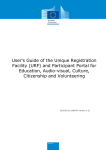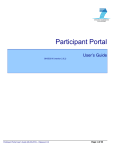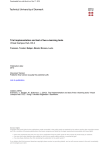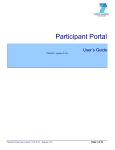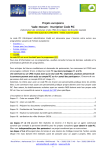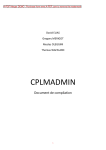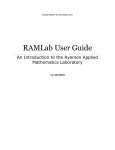Download URF - User Manual - Release 3.0
Transcript
1. INTRODUCTION The Unique Registration Service/Facility (URF) is an online web interface, providing access to the registration service for FP7 participants. Participants should register only once, so the registration process they go through should be unique. URF has been conceived to avoid redundant requests for information and to facilitate keeping up-to-date the information concerning the participants. In order to support this process, URF introduces the notion of the unique Participant Identification Code. The helpdesk's contact is: [email protected] Before self-registering, you must have an ECAS Password. A LEAR (Legal Entity Appointed Representative) must also have an ECAS password. ECAS stands for the European Commission's user Authentication Service. It allows authorised users to login to a wide range of Commission information systems, using a single username and password. Benefits of using the URF • Registering your organisation only ONCE; • Receiving a Participant Identification Code (PIC), which identifies your organisation (details and status;) • Confirmation and approval of your data done by ONE Central Validation Team (CVT) based on supporting documents; • Using the PIC in the process of electronic proposal submission and negotiation; • Multiple use of participant's data during all FP7 activities for all Research DG’s programmes ; • Validated information can be available during proposal submission; • The LEAR can provide relevant legal and financial data via the URF; • The organisation's data is updated in the relevant IT systems. URF - User Manual - Release 3.0 Document Version 1.2 dated 25/02/2009 Page 1 / 38 2. U.R.F. (UNIQUE REGISTRATION FACILITY) WELCOME SCREEN The first screen which appears when accessing the URF website is the Welcome Screen (see Figure 1 : URF Welcome screen). Figure 1 : URF Welcome screen According to your profile there are three different choices. • If you are a new user, then you need an ECAS login first. Select • If you already have an active ECAS Profile, then select • If you want to search for the PIC of an organisation, then select URF - User Manual - Release 3.0 Document Version 1.2 dated 25/02/2009 Page 2 / 38 REGISTER If your organisation does not already have an FP7 grant agreement, then you should register your organisation in URF. A PIC (Participant Identification Code) is provided at the end of the registration process that can be used after 48 hours for proposal submissions. During registration, URF does not check for duplicate registrations; this will be done at a later stage, if your proposal is retained for negotiation. Please note, when you register you will be given a PIC, which before being validated is a temporary PIC. When validated, the PIC becomes permanent, to be used for all correspondence and applications under FP7. Please note: Do not create a spontaneous application in URF if a PIC (temporary or permanent) already exists for your organisation. Do not use self registration screens to update incorrect data (appoint a LEAR and modifications entered by him or her will be treated as a priority). LOGIN If you are the LEAR (Legal Entity Appointed Representative), use this to view/update your organisation's data. SEARCH If you do not know if your organisation has a validated PIC, or if you search for the validated PIC of another organisation, it is mandatory to complete either the "Name of the organisation" field or the "VAT number" field with a string of at least three characters. The other search fields can be left blank. However, too unspecific queries may result in a long results list. If searching for a legal name in the national language does not yield results, you might try with a translation in English. URF - User Manual - Release 3.0 Document Version 1.2 dated 25/02/2009 Page 3 / 38 3. REGISTRATION AS A NEW USER TO OBTAIN AN ECAS PASSWORD 3.1. ECAS REGISTRATION Before accessing URF through a self registration or as a LEAR, you must have an ECAS Password. If you do not have an ECAS Password yet, please, click on the button ECAS Registration page will be displayed (see Figure 2: ECAS registration page) ; the Figure 2: ECAS registration page URF - User Manual - Release 3.0 Document Version 1.2 dated 25/02/2009 Page 4 / 38 - Fill in all the fields in the ECAS registration page: Tip: Before filling in the fields, be sure that you can read the characters in the Security Check image. If you cannot distinguish clearly these characters, then click on the [Try a different image] link to get a new set of characters. FIELD COMMENT USER NAME Optional YOUR FIRST NAME You should enter your first name (name of the person who is registering in ECAS). YOUR LAST NAME You should enter your family name (name of the person who is registering in ECAS) YOUR E-MAIL You should enter a valid e-mail address. This email address is needed to activate the process to obtain an ECAS account. Please note you cannot use the same e-mail address for several accounts. If you have to register another organisation, it is mandatory to provide a different e-mail address for each organisation. YOUR E-MAIL AGAIN Just to confirm your e-mail address. PRIVACY STATEMENT CONFIRMATION Acknowledge that you have read and understood the privacy statements TYPE THE CODE SHOWN SUBMIT It is a security measure to avoid “Robot registration”. You just have to type the code that you see. After clicking this button you will received an e-mail to confirm your registration Warning: Please note that the next step, regarding the confirmation of your ECAS registration and setting of the ECAS password (explained in Section 3.2) will have to be done within 30 minutes from when you first submit your registration request (through screen on Figure 2). - After filling in the fields on this screen, click on the [SUBMIT] button If all fields have been correctly filled in, the person registering will be notified through an e-mail message containing a link and the instructions to complete the registration with ECAS. URF - User Manual - Release 3.0 Document Version 1.2 dated 25/02/2009 Page 5 / 38 - The Account Confirmation page is displayed. You are warned that a confirmation e-mail is about to be sent to your e-mail address: "Thank you for registering; you will receive an e-mail allowing you to complete the registration process." See Figure 3: ECAS account creation confirmation. Figure 3: ECAS account creation - confirmation - You can now read your e-mail message. This is an example of the confirmation e-mail: From: European Commission Authentication Service To: your e-mail address Sent: Tuesday, January 20, 2009 11:45 AM Subject: Your password / Votre mot de passe English version Version française ci-dessous URF - User Manual - Release 3.0 Document Version 1.2 dated 25/02/2009 Page 6 / 38 Dear John Doe, Your account has been created by the European Commission Authentication Service. Your user name is nnnnnnnn. Please follow this link to initialize your password. If the above mentioned link does not work, you can copy-paste the following address (without any line break) in your browser address bar: https://ecast.cc.cec.eu.int:7002/ecas/init/initialisePasswordLogin.do?wayf.domain=external&way f.remember=checked&wayf.submit=Select&......... Sent to you by European Commission Authentication Service Version française Cher/Chère John Doe, Votre compte a été créé par le Service d'Authentification de la Commission Européenne. Votre nom d'utilisateur est nnnnnnn. Rendez-vous sur cette adresse pour initialiser votre mot de passe. Si le lien ci-dessus ne fonctionne pas, vous pouvez copier-coller l'adresse suivante (sans retour de ligne) dans la barre d'adresse de votre navigateur : https://ecast.cc.cec.eu.int:7002/ecas/init/initialisePasswordLogin.do?wayf.domain=external&way f.remember=checked&wayf.submit=Select&............ Ce message vous est adressé par le Service d'Authentification de la Commission Européenne 3.2. CONFIRMATION OF YOUR ECAS REGISTRATION – SET PASSWORD Warning: The process must be completed within 30 minutes from your original registration request (through screen on Figure 2). - In your ECAS confirmation e-mail message, click on the address link. The ECAS password initialisation page is displayed. See Figure 4: ECAS Password initialisation You have to enter: • Your user name • Your password twice. Leave your domain as 'External'. Note: Passwords may not include your username and must contain at least 10 characters chosen from at least three of the following groups (no other characters are permitted apart from the white space): • Upper case: A to Z • Lower case: a to z • Numeric: 0 to 9 • Special characters:!"#$%&'()*+,-./:;<=>?@[\]^ _ `{|}~ URF - User Manual - Release 3.0 Document Version 1.2 dated 25/02/2009 Page 7 / 38 Figure 4: ECAS Password initialisation When you click on the [SUBMIT] button, the "ECAS Password initialisation success" page will appear. See Figure 5: ECAS Password initialisation Success URF - User Manual - Release 3.0 Document Version 1.2 dated 25/02/2009 Page 8 / 38 Figure 5: ECAS Password initialisation Success Note: You must follow the link and complete the process within 30 minutes. If you do not complete the page within the 30 minutes, you will receive a page with the following message: See Figure 6: ECAS - registration time elapsed The time that has elapsed since this password reset request was confirmed exceeds the time allowed for the reset to be performed. If you still wish to change your password, please click here to make another request Clicking on the here link will allow you to reset your password. URF - User Manual - Release 3.0 Document Version 1.2 dated 25/02/2009 Page 9 / 38 Figure 6: ECAS - registration time elapsed URF - User Manual - Release 3.0 Document Version 1.2 dated 25/02/2009 Page 10 / 38 4. LOGIN TO URF FOR SELF REGISTRATION 4.1. Self Registration When you connect the first time to URF (not being a LEAR), you have to self register as participant. In your browser you connect to URF, using the following URL: http://ec.europa.eu/research/participants/urf/ The URF welcome page is displayed in your browser. See Figure 1 : URF Welcome screen button. The next page shows that you have not registered Then, you click on the any organisation yet. See Figure 7: URF Self Registration empty Figure 7: URF Self Registration empty To self register, just click on the [Register an Organisation] button. URF - User Manual - Release 3.0 Document Version 1.2 dated 25/02/2009 Page 11 / 38 4.2. Self-registration – Organisation data The first page to be displayed is related to the organisation's data. You have to fill in a set of fields (see table below). Complete the form with at least all the mandatory fields marked with *, in order to proceed to the next screen. Note the following buttons present on all the pages during self-registration. [NEXT STEP] [PREVIOUS STEP]: go to next/ previous registration page. [SAVE DRAFT]: save current data in a temporary URF database. [CANCEL]: cancel current work since last saved draft or last login. Figure 8: Self Registration - Organisation data FIELD COMMENT * PARTICIPANT LEGAL NAME Official name of the organization. This field should contain less than 240 characters. BUSINESS NAME The official acronym of your organization. This field should contain less than 40 characters. * OFFICIAL LANGUAGE Language used communication. 2nd LANGUAGE Language used for the translation of the legal name. URF - User Manual - Release 3.0 Document Version 1.2 dated 25/02/2009 within the organization for Page 12 / 38 FIELD COMMENT NAME IN 2nd LANGUAGE Translation of the legal name, usually to be provided in English. * LEGAL FORM This is a free text box. Please enter the form under which your organisation is legally registered, as in your organisation's statute. The legal form depends on the type of entity and the country. If your organisation is a private body, your form could be for example LLP, Ltd, PLC, SA, GmbH, etc. Please note that "university" or "public body" are not legal forms. After validation, this field will display the legal form as validated by the European Commission. * VAT NUMBER It is the unique number given to organisations that pay Value Added Tax (VAT). In the European Union, the VAT is a general, broadly based consumption tax, assessed on the value added to goods or services. Tips: If you are not sure about your VAT number, check with your financial department. If your organisation does not have a VAT number, you could enter “not applicable”. * REGISTRATION NUMBER Code usually provided by the Chamber of Commerce of your country. Tips: The registration number, the registration authority and the registration date are usually provided in the same document. Contact your financial department for more information. If your organisation does not have a registration number, you could enter “not applicable”. * REGISTRATION AUTHORITY The authority by which your organisation was registered, such as e.g. the administration of the city, or region, the Chamber of Commerce, etc. Tips: The registration number, the registration authority and the registration date are usually provided in the same document. If your organisation does not have a registration authority, you could enter “not applicable”. * NACE CODE The statistical classification of economic activities in the European Community (in French: Nomenclature statistique des activités économiques dans la Communauté européenne), commonly referred to as NACE, is a European industry standard classification system consisting of a 6 digit code. More info on: http://ec.europa.eu/eurostat/ramon/index.cfm?TargetUrl=DSP_PUB_ WELC * ESTABLISHMENT REGISTRATION COUNTRY Enter the location organisation. of the head-quarters of the * REGISTRATION DATE Date when your organisation was registered, for example with the Chamber of Commerce in your country. Tips: The registration number, the registration authority and the registration date are usually provided in the same document Enter 0101-1900 if not applicable”. URF - User Manual - Release 3.0 Document Version 1.2 dated 25/02/2009 Page 13 / 38 Complete the form with at least all the mandatory fields marked with *, in order to proceed to the next screen. URF - User Manual - Release 3.0 Document Version 1.2 dated 25/02/2009 Page 14 / 38 4.2.1. Self-registration – Legal Address Figure 9: Self Registration - Legal address FIELD COMMENT * STREET NAME Street where the organisation is established STREET NUMBER Number or name of the building on the street (max. 20 aphanumerical characters) PO BOX If the organisation has a postal box COUNTY / REGION Enter your county/region * POSTAL CODE ZIP CODE of the organisation * CEDEX Only for France * CITY Official name of the city where the organisation is established * COUNTRY Select the country where the organisation is established INTERNET HOMEPAGE The format should be www.homepage.domain FAX Format should be: (international code) and FAX number without space * PHONE 1 Format should be: (international code) and PHONE number wihout space PHONE 2 Format should be: (international code) and PHONE number without space COMPANY E-MAIL This information was transferred from the initial Registration screen. URF - User Manual - Release 3.0 Document Version 1.2 dated 25/02/2009 Page 15 / 38 Complete the form with at least all the mandatory fields marked with *, in order to proceed to the next screen. URF - User Manual - Release 3.0 Document Version 1.2 dated 25/02/2009 Page 16 / 38 4.2.2. Self-registration – Main contact data This person is to be contacted until a person is validated as LEAR for the organisation. For further explanations on LEAR, please see: http://cordis.europa.eu/fp7/urf-lear_en.html Figure 10: Self Registration - Main contact data FIELD COMMENT TITLE The title: Mr., Mrs., Prof., Dr. … * GENDER Specify the gender * LAST NAME Automatically filled with the last name registered field can be modified * FIRST NAME Automatically filled with the first name registered field can be modified * POSITION IN ORGANISATION The title in your organisation DEPARTMENT The department in your organisation * CONTACT COUNTRY Select the country where you are established * CONTACT STREET Enter the street name * CONTACT STREET NUMBER Fill with the street number PO BOX Fill with the PO BOX number COUNTY / REGION Enter the county/region * POST CODE Enter the ZIP CODE of your address URF - User Manual - Release 3.0 Document Version 1.2 dated 25/02/2009 Page 17 / 38 FIELD COMMENT * CEDEX Only for France * CITY Official name of the city INTERNET HOMEPAGE The format should be: www.homepage.domain FAX Format should be: (international code) and your FAX number without space * PHONE 1 Format should be: (international code) and your PHONE number without space PHONE 2 Format should be: (international code) and your PHONE number without space E-MAIL 1 Automatically filled with the registered e-mailcan be modified Complete the form with at least all the mandatory fields, in order to proceed with the next screen. URF - User Manual - Release 3.0 Document Version 1.2 dated 25/02/2009 Page 18 / 38 4.2.3. Self-registration – Status of the Organisation In the "Status of your organisation" screen, please select the right status for your organisation. The status selected will need to be demonstrated by your statute and registration document. For the definitions of the status of organisations, please see below and consult the "REGULATION (EC) No 1906/2006 OF THE EUROPEAN PARLIAMENT AND OF THE COUNCIL of 18 December 2006 laying down the rules for the participation of undertakings, research centres and universities in actions under the Seventh Framework Programme and for the dissemination of research results (2007-2013)". To access the regulation, follow the link: http://eur-lex.europa.eu/LexUriServ/LexUriServ.do?uri=OJ:L:2006:391:0001:0018:EN:PDF Figure 11: Self Registration - Status of the Organization URF - User Manual - Release 3.0 Document Version 1.2 dated 25/02/2009 Page 19 / 38 In the "Status of your organisation" screen, please select the right status for your organisation. FIELD Indirect cost calculation method COMMENT The indirect cost calculation method is chosen by the participant. Indirect costs, also called overheads, are all the eligible costs which cannot be identified by the beneficiary as directly attributed to the project, but can be identified and justified by its accounting system as being incurred in direct relationship with the eligible direct costs of the project. The available options for the choice are determined by the legal status of the participant, the status of their accounting system and the history of indirect cost calculation methodologies in previous FP7 participations. The options are described as follows: o Actual or real indirect costs: available for all categories of beneficiaries which have an analytical accounting system to identify their indirect costs. A simplified method is also available for all categories of beneficiaries which are unable to perform detailed cost allocation and can aggregate their indirect costs only at the level of the legal entity, unless they used actual indirect costs before. The simplified approach must be based on actual costs derived from the financial accounts of the period in question. o Standard flat rate: available for all categories of beneficiaries, unless they used actual indirect costs or the simplified method before. The flat rate is of 20% of its total direct eligible costs, excluding its direct eligible costs for subcontracting and the costs of reimbursement of resources made available by third parties which are not used on the premises of the participant. o Special transitional flat-rate: available for non-profit public bodies, secondary and higher education establishments, and research organisations and SMEs, which are unable to identify with certainty their real indirect costs and unless they used actual indirect costs or the simplified method before. When participating in funding schemes which include research and technological development activities may opt for a flat-rate of 60% of the total direct eligible costs. This flat-rate of 60% excludes costs for subcontracting and the costs of reimbursement of resources made available by third parties which are not used on the premises of the participant. If these participants change their status during the life of the project, this flat rate shall be applicable up to the moment they lose their status. The participant shall apply the same indirect cost calculation method in all grant agreements under the Seventh Framework Programme. Tips: View the financial guide page 45 to 51 for explanation of the method of calculation of indirect costs: ftp://ftp.cordis.europa.eu/pub/fp7/docs/financialguide_en.pdf URF - User Manual - Release 3.0 Document Version 1.2 dated 25/02/2009 Page 20 / 38 FIELD COMMENT Natural Person A "natural person" is a citizen (to be distinguished from "legal persons", which refer to corporations). Natural persons always have legal personality and are therefore legal entities without other proof being required than their identification papers. Individuals who are registered as free-lance professionals and have a VAT number, are also legal persons. Please note, that citizens who are freelance-professionals and want to be validated as FP7 participants, have to choose whether they want to apply as "natural person" or as "legal person". Legal person For a "legal person" to exist, an act of incorporation and usually also a registry is required. A legal person exercises rights and is subject to obligations with regard to the national law of its place of establishment, community law or international law. A legal person can group other legal entities (natural or legal), or contain only possessions (e.g. foundation). Non profit A legal entity is qualified as a "non-profit organisation", when considered as such by national or international law (international organisations as well as any specialized agency set up by international organisations). Generally, as a consequence, any possible profits have to be reinvested within the organisation itself and cannot be distributed. The quality of being a non-profit organisation has to be proven by your statute. Research organisation "Research organisation" means a non-profit organisation which carries out scientific or technical research as its main objective. The quality of being a research organisation has to be stated in your statute. Public body "Public body" means any legal entity established as such by national public law, and international organisations. Bodies providing services of public interest are not necessarily public bodies. The quality of being a public body has to be stated in your statute. International organisation "International organisation" means an intergovernmental organisation, other than the European Community, which has legal personality under international public law, as well as any specialized agency set up by such international organisations. International organisation of European interest "International organisation of European interest" means an international organisation, the majority of whose members are Member States or Associated Countries, and whose principal objective is to promote scientific and technological cooperation in Europe. Higher or secondary education establishment It is an organisation which has as main objectives training and education, and delivers state recognized diplomas. URF - User Manual - Release 3.0 Document Version 1.2 dated 25/02/2009 Page 21 / 38 Enterprise Any entity engaged in an economic activity, irrespective of its legal form. This includes commercial companies, but also self-employed persons and family businesses engaged in craft or other activities, as well as partnerships or associations regularly engaged in an economic activity. SME "SMEs" are micro, small and medium-sized enterprises within the meaning of Recommendation 2003/361/EC in the version of 6 May 2003. Tips: To determine what type of SME your organisation is, see http://ec.europa.eu/research/sme-techweb/index_en.cfm Number of employees < 250 Click the check box if your organization has less than 250 employees Annual turnover <50M Click the check box if the annual turnover is less than € 50 millions Annual balance sheet <43M Click the check box if the annual balance sheet is less than € 43 millions Autonomous Click the check box if your organization is autonomous URF - User Manual - Release 3.0 Document Version 1.2 dated 25/02/2009 Page 22 / 38 4.2.4. Self-registration – Summary of your data The final screen summarises all values entered in the previous screens. You are still able to provide corrections by selecting the [Edit] buttons for each section. Figure 12: Self Registration - Summary of your data After verification and when the data provided are correct, you have to select the [CONFIRM] action to submit the information to the Validation Team CVT. Note that you will not be able to URF - User Manual - Release 3.0 Document Version 1.2 dated 25/02/2009 Page 23 / 38 correct the organisation data in URF until the Validation Team processes the information submitted and the Legal Entity Appointed Representative has been appointed and validated (see below). You can also suspend your verification by clicking the [Save Draft] button. 4.2.5. Self-registration – Confirmation After you having confirmed your data by selecting the [CONFIRM] button, the confirmation page is displayed. See Figure 13: Self Registration - Confirmation Note: Your Participant Identification Code (PIC number) is displayed on the page. Figure 13: Self Registration - Confirmation Immediately after the data has been submitted for validation, you will receive an e-mail with the data you entered, and a Participant Identification Code (PIC) will be provided to you. This is an example of the confirmation e-mail: From: [email protected] [email protected] To: your_email_registered Subject: Your registration at PDM/URF Dear Mr. / Mrs. John Doe, The Research Directorates-General of the European Commission thank you for having registered your legal entity in our database of participants. URF - User Manual - Release 3.0 Document Version 1.2 dated 25/02/2009 Page 24 / 38 The record has been successfully created. The Participant Identification Code (PIC) for the legal entity you have registered is 123456789. If you intend to use your PIC for proposal submission, please note that there is a delay of 48 hours before the associated data is visible to EPSS. This time constraint effectively prevents you from submitting a proposal to a call closing within the next two days using the above-mentioned PIC. If you have registered because your organisation is currently negotiating a grant agreement, please provide us as soon as possible with the supporting documents so that your organisation can be validated. On the link - http://cordis.europa.eu/fp7/urf-valid_en.html - you can find downloadable forms and instructions for the submission of supporting documents. Please note that the validation could result in a possible change of the PIC. If you are negotiating a grant agreement, you are also kindly invited to launch the process of appointment of the Legal Entity Appointed Representative (LEAR) within your organisation. The LEAR will be the responsible for updating in URF the legal and financial data of your organisation. On the link - http://cordis.europa.eu/fp7/urf_en.html - you can find downloadable forms and instructions for the appointment of the LEAR. You will find as well some additional information regarding the PIC usage and the LEAR. The Central Validation Team Below is the summary of your entered data: Organisation Data ================= Legal name : xxxxxxx Business name : xxxxxxx Official language : xxxxxx Translated name : xxxxxx Translated language : xxxxxx Legal form : xxxxx VAT number : xxxxxxxx Registration number : xxxxxxxx Registration date : xxxxxxxx Registration authority : xxxxxxxxx NACE Code : xxxxxxxxx Registration country : xxxxxx Legal Address ================ Street name : xxxxxxx Street number : 12345789 PO box : 123456789 Region/County : Postal code : 123456789 CEDEX : City : xxxxxx Country : xxxxxxx Internet homepage : www.myorganisationwebpage.domain Fax : +123 1234567890 Phone1 : +123 1234567892 Phone2 : +123 1234567891 Email1 : [email protected] Main Contact Person =================== Contact Title : XXXXX Contact Gender : X Contact Position in organisation : XXXXXXX Contact Department : XXXXXXX Contact Last name : XXXXXXX Contact First name : XXXXXXX Contact Country : XXXXXXX Contact Street : XXXXXXX Contact Street number : 123456 Contact PO box :123456 Contact Region/County : XXXXXXXX Contact Postal Code : 123456 Contact CEDEX : 123 Contact City : XXXXXXXXX Contact Internet homepage : www.XXXXXX.XXX Contact Fax : +123 123456789 Contact Primary phone : +123 1234568788 Contact Secondary phone : +123 12345787 Contact E-mail : [email protected] Status of the Organisation ========================== Indirect Cost Method : Standard Flat Rate Is it a Natural Person? X Is it a Legal Person? X Is it a Non profit? X Is it a Research organisation? X Is it a Public body? X Is it an International Organisation? X Is it an International Organisation of European Interest? X URF - User Manual - Release 3.0 Document Version 1.2 dated 25/02/2009 Page 25 / 38 Is it a Higher or secondary education establishment? X Is it an Enterprise? X Self declared SME Status? X Is the number of employees below 250? X Is the annual turnover below 50M? X Is the annual balance sheet below 43M? X Is it autonomous? X Your comments: XXXXXXXXXXXXXXXXXXX URF - User Manual - Release 3.0 Document Version 1.2 dated 25/02/2009 Page 26 / 38 4.3. Modify Self-registration data During Self registration, if you have saved your data by using the [SAVE DRAFT] button, you will be directed to the following page: Figure 14: Self Registration - Modify draft data. The same page is also displayed if you login again during self registration. Figure 14: Self Registration - Modify draft data You can modify your data by clicking on the [UPDATE] button. Then you will have access to the different pages described above. URF - User Manual - Release 3.0 Document Version 1.2 dated 25/02/2009 Page 27 / 38 4.4. View Self-registration data During self-registration you can modify your data (data which is not confirmed yet, but saved as draft – see Figure 12) by using the [UPDATE] button (see Figure 14). After your self registered data have been submitted (using the [CONFIRM] button shown in Figure 12) , you cannot modify your data anymore, until it is validated by the CVT. You can in the meanwhile view your data only as reand-only by clicking on the [VIEW] button. Figure 15: Self Registration - Data under validation Your registered data can then be seen in read-only mode (see Figure 16: Self Registration View data under validation) From these pages you can always logout ([LOGOUT] button) or go back to the URF menu ([Return URF menu] link). URF - User Manual - Release 3.0 Document Version 1.2 dated 25/02/2009 Page 28 / 38 Figure 16: Self Registration - View data under validation URF - User Manual - Release 3.0 Document Version 1.2 dated 25/02/2009 Page 29 / 38 4.5. Login as a LEAR This login is to be used by the persons who have been validated as LEAR (Legal Entity Appointed Representative) of their organisations. As a LEAR you can connect using your ECAS account: At first, you receive by email your username and explanation on how to activate your account. Subject: 7th Framework Programme - User account creation Dear John Doe, In the context of the 7th Framework Programme, you have recently been nominated as the LEAR for your organisation. In order to access the Unique Registration Facility (URF), the web application that allows you to manage the data of your organisation, an account has been created for you by the European Commission. Once activated, this account can be used to access initially the Unique Registration Facility (URF) and subsequently, it may be possible for you to access other Commission sites. Your user name is: nnnnnnnn (Note: you can also use your registered email address instead of the username to access your account). You will soon receive by letter (and if possible, by phone) your personal identification number (PIN) required to activate your account. When you receive the PIN, please visit this link and follow the instructions on screen to activate your account. Please make sure that the domain that is selected in ECAS is "External", not European Commission. You will be asked to provide your user name and PIN. Then, you will be offered the opportunity to choose a password of your liking. Please choose your password wisely in accordance to the instruction provided on the pages. When you have completed these steps, your account will be automatically activated. If the above mentioned link does not work, you can copy the following address (without any line break) and paste it in your browser address bar: https://webgate.ec.europa.eu/ecas/init/PINCode.do?domain=external Once your account has been activated, you can visit the URF application at the following address: http://ec.europa.eu/research/participants/urf If you believe that this message has reached you in error or should you require any further assistance, please do not hesitate to contact our eFP7 Service Desk using the coordinates provided below. The eFP7 Service Desk Team E-mail: [email protected] Phone: +352 4301 31570 Fax: +352 4301 33099 URF - User Manual - Release 3.0 Document Version 1.2 dated 25/02/2009 Page 30 / 38 For the LEAR that self registered, the mail is quite different : From: DIGIT CED CUD SUPPORT Sent: Thursday, February 19, 2009 5:27 PM To: [email protected] Subject: 7th Framework Programme - User account upgrade Importance: High Sensitivity: Private Subject: 7th Framework Programme - User account upgrade Dear John Doe In the context of the 7th Framework Programme, you have recently been nominated as the LEAR for your organisation. In order to access the Unique Registration Facility (URF), the web application that allows you to manage the data of your organisation, you can use the existing user account that was previously created for you by the European Commission. Nevertheless, you are required to upgrade this account. Your user name is: username (Note: you can also use your registered email address instead of the username to access your account). In order to start using the system, your account must be upgraded. You will soon receive by letter (and if possible, by phone) your personal identification number (PIN) required to upgrade your existing account. When you receive the PIN, please visit this link and follow the instructions on screen to activate your account. Please make sure that the domain that is selected in ECAS is "External", not European Commission (see the attached file). You will be asked to provide your user name and PIN. Then, you will be offered the opportunity to choose a password of your liking. Please choose your password wisely in accordance to the instruction provided on the pages. When you have completed these steps, your account will be automatically activated. If the above mentioned link does not work, you can copy the following address (without any line break) and paste it in your browser address bar: https://webgate.ec.europa.eu/ecas/init/PINCode.do?domain=external Once your account has been activated, you can visit the URF application at the following address: http://ec.europa.eu/research/participants/urf We regret that, for technical reasons, you will be unable to use your existing account for access to any Commission information system until your account has been upgraded. Please contact us if you have an urgent need for access but have not yet received your PIN. If you believe that this message has reached you in error or should you require any further assistance, please do not hesitate to contact our eFP7 Service Desk using the details provided below. The eFP7 Service Desk Team E-mail: [email protected] Phone: +352 4301 31570 Fax: +352 4301 33099 URF - User Manual - Release 3.0 Document Version 1.2 dated 25/02/2009 Page 31 / 38 And a letter with your PIN code is also sent : EUROPEAN COMMISSION DIRECTORATE-GENERAL INFORMATICS Directorate B - Information systems e-Commission, Interoperability, Architecture and Methods Dear John DOE, Re: your nomination as Legal Entity Authorised Representative (LEAR) The European Commission's Unique Registration Facility is a web-based application for participating organisations in the Seventh Research Framework Programme. This online service allows registered users to view and update their organisation's legal and financial data. According to our records, you are the Legal Entity Authorised Representative (LEAR) for the above-mentioned organisation. The European Commission Authentication Service (ECAS) has therefore created a user account for you to access the Unique Registration Facility and manage your organisation's data. An email was sent to your registered email address: aaaa.bbbb@aba It explains how to activate your new user account using a PIN code. Please follow the instructions carefully. Your activation PIN is: xxxxx Your user account is strictly personal and will allow you in future to access other online services the European Commission is currently developing for the Seventh Research Framework Programme and the Competitiveness and Innovation Programme. Please contact the eFP7 Service Desk if any of the information about yourself or your organisation contained in this letter is inaccurate or if you have any problem activating your account. Yours sincerely, URF - User Manual - Release 3.0 Document Version 1.2 dated 25/02/2009 Page 32 / 38 Figure 17 : ECAS Password initialisation for LEAR After login, you can see the following page ( Figure 18: LEAR - Organization page) The first part of the page contains the history of the requests related to your organization and some buttons allowing you to view or modify those different requests. The second part, related to your registration, allows you to view your data in the URF registry. URF - User Manual - Release 3.0 Document Version 1.2 dated 25/02/2009 Page 33 / 38 Figure 18: LEAR - Organization page URF - User Manual - Release 3.0 Document Version 1.2 dated 25/02/2009 Page 34 / 38 4.5.1. Modify data As a LEAR, you are able to modify your data (when the [UPDATE] button is enabled in the page above). The modification page (Figure 19: LEAR - Modifications of the validated data ) contains 3 tabs: • Organisation data • Legal address (see Figure 19: LEAR - Modifications of the validated data) • Status of the organisation Figure 19: LEAR - Modifications of the validated data In these different tabs, an [UPDATE YOUR DATA] button is present. This button saves all the data from ALL tabs. Once this button is clicked, a confirmation page appears. You are then asked to confirm or cancel your modifications (see Figure 19: LEAR - Modifications of the validated data). URF - User Manual - Release 3.0 Document Version 1.2 dated 25/02/2009 Page 35 / 38 Figure 20: LEAR- Confirmation of modifications When you confirm your modifications by clicking on the [SUBMIT] button, another confirmation page is displayed (see Figure 20: LEAR- Confirmation of modifications ) Figure 21: LEAR modifications submitted You can then logout or return to the URF menu (see Figure 22: LEAR - Organization page with new request) URF - User Manual - Release 3.0 Document Version 1.2 dated 25/02/2009 Page 36 / 38 You can see that the URF menu page has changed in the Request history part: • The first request is now in read-only: only the [VIEW] button is enabled • Your submitted modifications are displayed in the second request. While the CVT (Central Validation Team) has not yet set the request status to 'UNDER VALIDATION', you will be able to update or delete your request. Figure 22: LEAR - Organization page with new request URF - User Manual - Release 3.0 Document Version 1.2 dated 25/02/2009 Page 37 / 38 5. SEARCH PIC The URF website provides a tool to search for the PIC of any organisation registered in URF. In order to find the PIC of an organisation, you only need to fill in the search criteria. It is mandatory to complete either the "Name of the organization" field or the "VAT number" field with a string of at least three characters. The other search fields can be left blank. However, too unspecific queries may result in long results' lists. The results' lists are truncated after 20 record listings. If searching for a legal name in the national language does not yield results, you might try with a translation of the organisation's name in English. Type also the code on the image (upper and lower case may be used interchangeably). Tip: If the letters in the image are not easily readable, click on the [RESET] button to get a new image. Click on [SEARCH] to display the results. Figure 23 : Search Participants URF - User Manual - Release 3.0 Document Version 1.2 dated 25/02/2009 Page 38 / 38







































